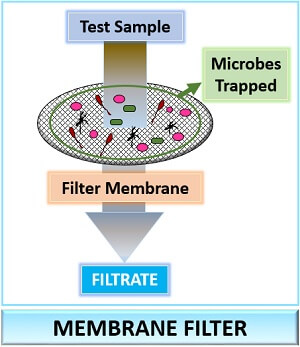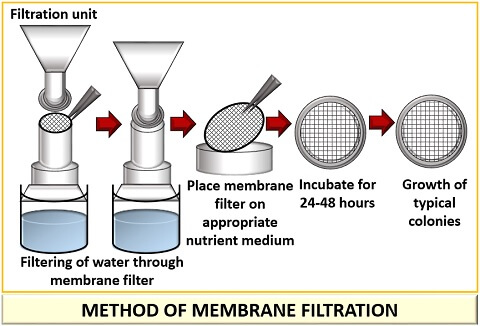Membrane filtration method is an alternative to the MPN method for the microbiological analysis of water. Sometimes, it also refers to as “Millipore filter technique” or “MF technique”. The Millipore filter technique was named by the two scientists Goetz and Tsuneishi in 1951. Membrane filtration method makes the use of membrane filter, or we can say millipore filter. A millipore filter possesses a uniform porosity or a predetermined pore size of 0.45 µm.
The pores in the membrane filter are sufficiently small enough to trap the different types of microorganisms. A membrane filter is composed of polymeric substances. Membrane filtration method requires an apparatus, i.e. membrane filtration assembly to perform the water analysis.
A filtration unit comprises many components like a funnel, vacumn pump, filter flask, filter pump etc. Here, you will get to know the definition, summary, method, advantages and disadvantages of the membrane filtration method. Also, the common terms like membrane filter, absorbent pad and membrane filtration assembly are also explained in this lesson.
Content: Membrane Filtration Method
- Definition of Membrane Filtration Method
- Membrane Filter
- Absorbent Pad
- Membrane Filtration Assembly
- Summary
- Method of Membrane Filtration
- Advantages
- Disadvantages
- Conclusion
Definition of Membrane Filtration Method
Membrane filtration method is an assessment of water quality through the use of a special filter, i.e. membrane filter to trap the microorganisms. It is a very effective method for the isolation and enumeration of microorganisms in the test water sample. Using the MF method, we can determine the water quality by knowing the quantity of microbial mass in the test sample. Therefore, the membrane filtration method inspects both the quality of water and the quantity of microorganisms in the water.
Discovery: Membrane filtration method was introduced in the late 1950s and widely accepted by the U.S. EPA (Environmental Protection Agency). According to U.S. EPA (Environmental Protection Agency), membrane filtration is the best technique for the water analysis, as it allows the testing of a large volume of water sample within less time.
Purpose: The main objective of the membrane filtration method is to determine the presence or absence of particular coliform group in the wastewater and groundwater. The water quality is analysed by directly counting the number of colonies through colony counter. One colony of bacteria will represent the single bacterium in the 100 ml of a water sample.
Membrane Filter
The membrane filter is the molecular or biological filter, composed of biologically inert cellulose esters. It possesses a uniform or predetermined pore size, which traps the different types of microorganisms whose size ranges from 0.01-0.10 µm. The membrane filters are widely used in laboratories for the isolation and separation methods.

In industries like pharmaceuticals, cosmetics, food and beverages etc. the membrane filters are used to monitor the presence of bacteria and to sterilize the heat-labile fluids. Besides this, membrane filters are extensively used in water engineering to analyse the quality of water by the direct microbial count.
Absorbent Pad
An absorbent pad consists of filter paper disks (free of sulphites and other compounds), which suppresses the growth of bacteria. The MF technique uses absorbent paper of diameter 48 mm with a thickness of 0.8 mm. The absorbent paper absorbs 1.8-2.2 ml of the nutrient medium.
We need to saturate the absorbent pad with the appropriate liquid broth medium, to which 1.5% of agar is added further. Over the saturated absorbent medium, place a membrane filter and incubate it for the growth of bacterial colonies.

Membrane Filtration Assembly
To perform membrane filtration, there is a filtration unit popularly known as “membrane filtration assembly”. It comprises funnel, locking ring, carbon disc, stainless base, rubber stopper, filter flask and vacumn pump. Let us discuss the working of membrane filtration assembly.
Firstly, we need to place a membrane filter over the carbon disk. Then, one should pass the water sample through a stainless funnel (at the top). A locking ring or clamp below the funnel controls the flow of the test water sample. The stainless base holds the carbon disc and the membrane filter.
At the base, a rubber stopper controls the flow of water to the filter flask. On the one end of filter flask, there is a connector that connects the vacumn motor with the filtration unit. A vacumn provides a negative pressure, which permits the suction of filtrate through the membrane filter.

Summary
- Through the MF technique, 100ml of the sample can easily pass from the filter membrane with a pore size of 47 mm by means of filtration assembly. The membrane filter confines the organisms on its surface.
- Transfer the confined microbial mass over the surface of the membrane filter to the Petri dish containing a nutrient medium. The membrane filter facilitates the passage of nutrients from the media added to the Petri plate to the organisms trapped.
- The passage of nutrients allows the growth of microorganisms and results in the formation of discrete colonies. The culture plate can be further testing by using confirmation or selective media to confirm the type of organism present in water.
Method of Membrane Filtration
A membrane filtration method involves the following steps:

Sample collection: Collect water samples like groundwater (high in Cu and Zn) and wastewater (high in heavy metals) in the sterilized sample bottles. Then, dilute the water sample by making a volume of up to 100 ml.
Selection of appropriate nutrient medium: For the isolation and enumeration of different pathogenic microorganisms in water, we can use a variety of nutrient medium.
| Microorganisms in water | Nutrient medium used |
|---|---|
| Total coliforms | MF- Endo |
| Fecal coliforms | M- FC |
| Yeast and Molds | M- Green YM |
| Total bacteria | M- TGE / Trypticase Soy USP |
| Fecal streptococci | KF- Streptococcal |
| Lactobacillus acid resistant bacteria | Orange serum |
After selecting an appropriate nutrient medium, prepare and transfer the media to the sterilized Petri plate containing absorbent pad at the bottom. Soak the absorbent pad with the liquid broth. The saturation of the absorbent pad with the nutrient medium will promote microbial growth.
Membrane filtration: For the membrane filtration of water, place a membrane filter over the carbon disk by using forcep sterilized under the flame. Then, flame the opening of the sample bottles and pour the test water sample, through the funnel. A vacumn system allows the complete separation of filtrate through the membrane filter. After complete separation of filtrate, rinse the funnel with the buffered water.
Transfer of membrane filter: Flame the forcep and take out the membrane filter from the filtration assembly. Then, place a membrane filter over the prepared petri dish containing absorbent pad saturated with a liquid nutrient medium. Finally, incubate the Petri plate for 24-48 hours at 35-37 degrees Celsius temperature.
Observation: For the quantitative analysis, we need to count the number of colonies directly on the colony counter. Conversely, to test the water quality, we need to isolate and identify the type of microorganisms by subculturing the isolated colonies. Further, we could examine the specific type of microbial group through staining methods, microscopic observations and biochemical tests.
Advantages
- MF technique is an alternative to the most probable number method.
- One can test a large volume of a water sample through the millipore filtration method.
- Membrane filtration consumes less time than the MPN method, as it only involves four to five steps to get the results.
- MF technique gives relevant and reliable results than the MPN method.
- One can enumerate the number of bacteria present in the water sample directly by using the colony counter.
Disadvantages
- Membrane filtration method is not applicable to test the turbid water.
- There may be a chance of bacterial overgrowth, as the water contains many microorganisms.
Conclusion
Therefore, the membrane filtration method is an efficient method to isolate and enumerate the number of microorganisms from the microbiologically contaminated fluid sample. Membrane filtration method determines the microbial population by counting the number of discrete colonies, which is an advantage over the MPN method. In contrast to membrane filtration method, the MPN method determines the microbial density based on the turbidity of the culture broth.